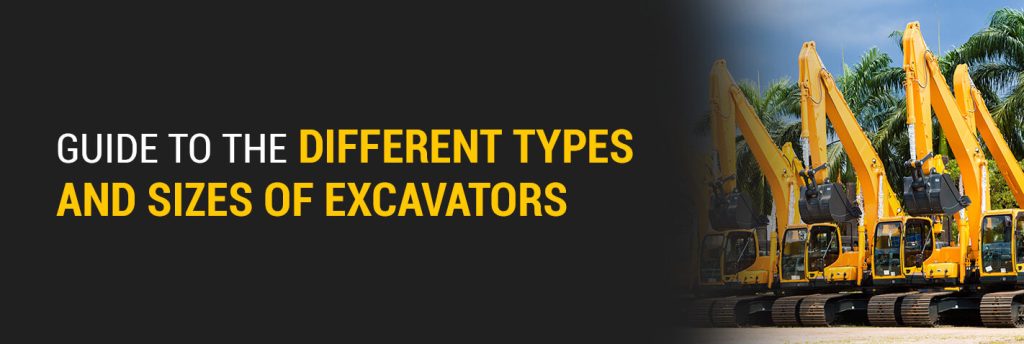
The construction, building and mining industries rely on excavators for heavy-duty applications, including digging and hauling materials. Excavators provide an excellent way to increase productivity and efficiency at your job site while reducing operating costs.
Selecting the right excavator involves considering power, size, and application needs to ensure it meets the demands of your projects. In this guide, you’ll learn about the different types of excavators—including standard, wheeled, and mini—along with their weight classes and sizes to help you choose the best option for your application.
You have many flexible options for excavation models and equipment types to meet the needs of your applications. Different types of excavators or diggers are better suited to heavy-duty jobs, while others are ideal for less intensive tasks. Some of the most common excavation equipment types and their uses include:
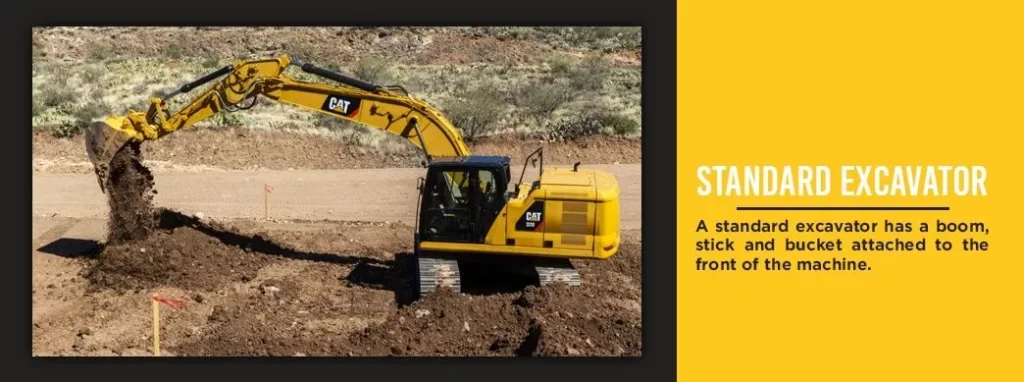
Standard excavators, also known as crawler excavators, use a boom, stick and bucket arm attachment at the front of the equipment. These excavators are designed to handle the bulk of the work and are often used in heavy-duty construction, mining, farming, landscaping and other industries.
The bucket arm attachment extends to dig through soil or other materials and retracts to lift materials. The cab is capable of rotating 360 degrees, making it easier to dig and dump different materials. These excavators use rotating tracks to provide traction and stability, which allows them to navigate steep slopes or rugged terrain. Standard excavators also have tracks that exert less ground pressure, making them a popular option for various jobs.
You can choose from different excavator sizes to suit your applications, whether you need a machine that can fit into higher spaces or something that works in heavy-duty situations. You can also choose from different bucket sizes to help you complete other tasks at your worksite, such as moving debris or materials, demolition, trenching and hauling.
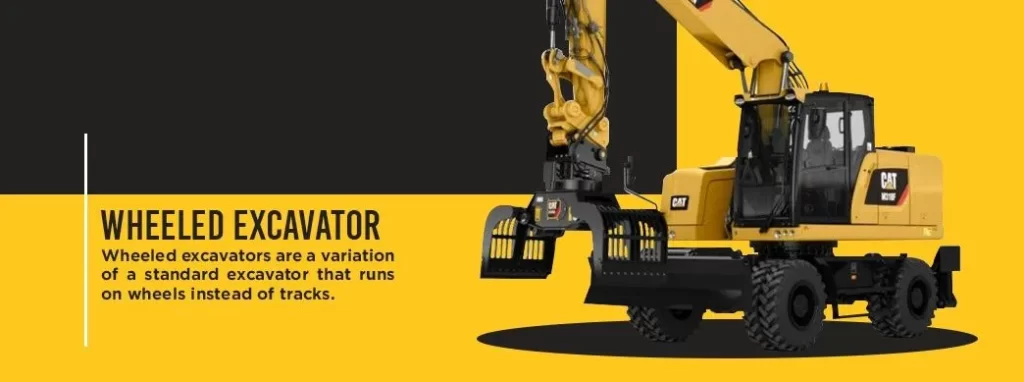
While standard excavators run on tracks, these excavators run on wheels. Wheeled excavators have the same capabilities, size options and general appearance as standard excavators.
Their wheels allow them to maneuver on tough terrains, including asphalt, concrete and uneven soil. Wheels have a higher ground pressure that reduces their traction, so they’re not suited for slopped or hilly terrain applications. Instead, these excavators are used more often for urban construction or roadwork.
You can generally drive wheeled excavators from one job site to the next without needing a trailer, saving time and money. Wheeled excavators work best on flat worksites and can improve speed and maneuverability when digging and transporting materials.
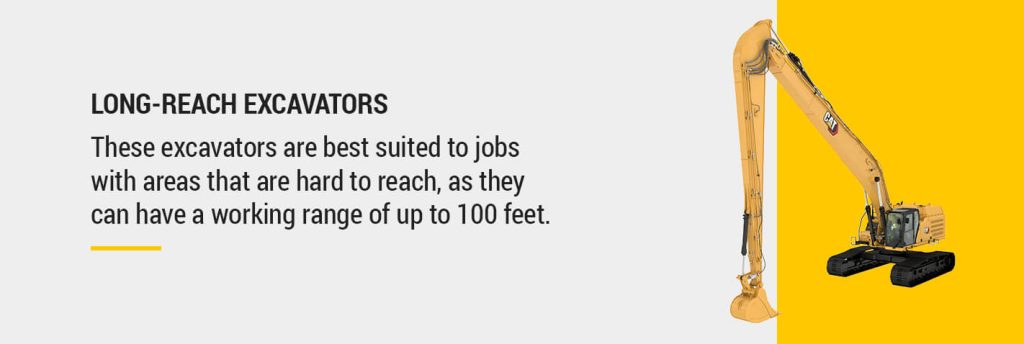
Long-reach excavators are similar to standard excavators but use an extended arm and boom. These excavators are best suited to jobs with areas that are hard to reach, as they can have a working range of up to 100 feet. Long-reach excavators are often used during challenging and tight excavation or demolition jobs.
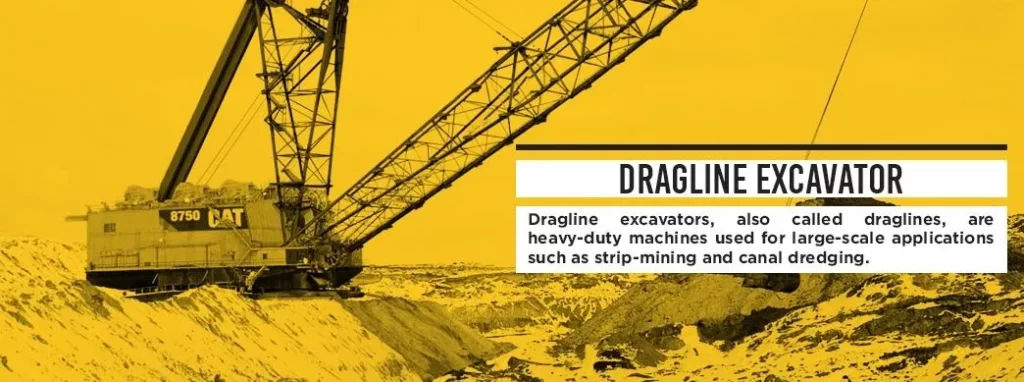
Dragline excavators are heavy-duty equipment best suited to large applications such as harbor construction, canal dredging and strip mining. These excavators are larger than standard excavators and are often assembled on-site.
Dragline excavators use a bucket system that drags along the surface with chains and wire rope. The bucket is attached to the boom and is hoisted after excavation. The excavator rotates to the dump location and releases the bucket to dump the excavated materials.
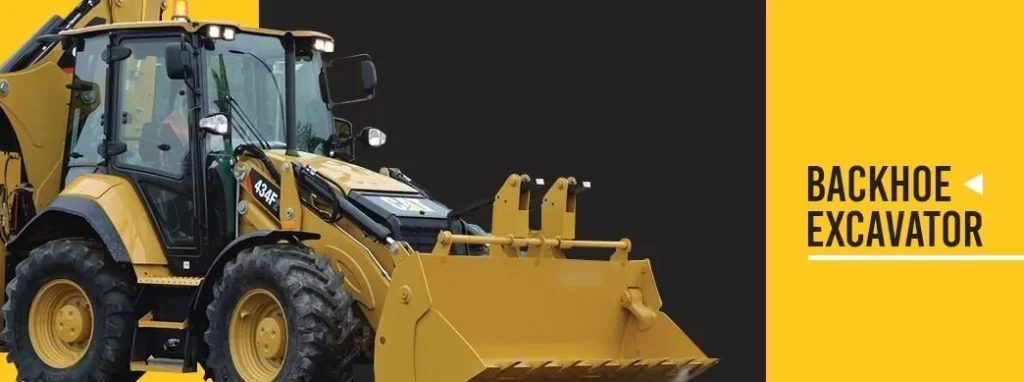
Backhoe excavators are often confused with crawler excavators. Backhoe loaders have the boom attached to the back of the equipment rather than the front. The front of the backhoe excavator features a bucket and blade that pushes, levels and moves materials. Backhoes can also only rotate 200 degrees instead of a total of 360.
Despite their limited rotation, choosing a backhoe loader with excavator attachments has some benefits. Backhoe excavators are more versatile and can simultaneously accomplish digging tasks and soil leveling and grading. These machines can also quickly move larger quantities of materials and can be paired with work tool attachments to increase their versatility.
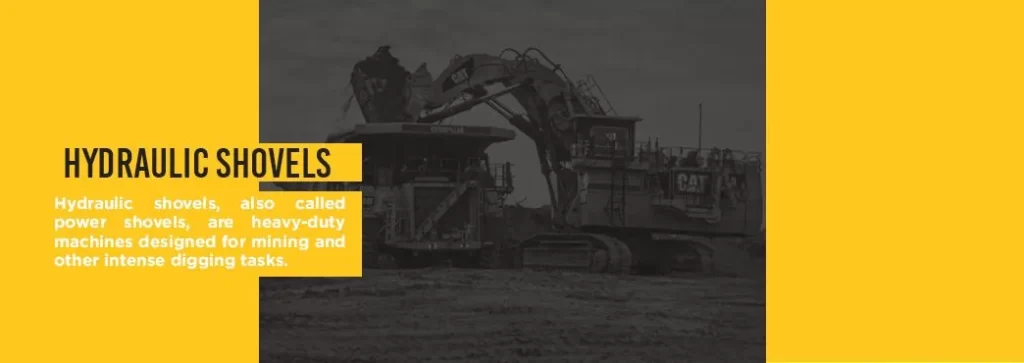
Hydraulic shovels are suited for heavy-duty tasks within the mining industry but can also work for hydro excavation and intense singing processes. These machines feature powerful lifting arms and a large bucket for carrying soil, minerals, rocks and other heavy materials. There are different orientations for hydraulic shovels, including the bucket facing the machine’s cab or a bucket facing away from the cab, based on the needs of your operators and applications.
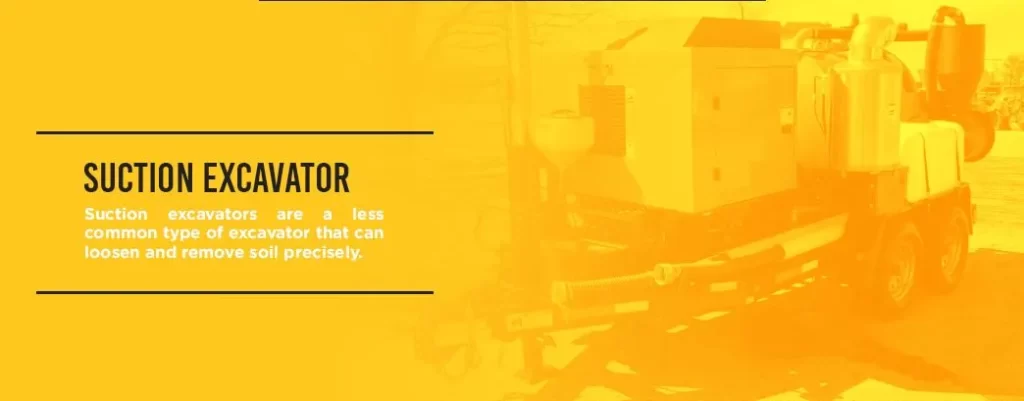
Suction or vacuum excavators can help loosen soil and remove it from your worksite, which makes them ideal for excavation and trenching jobs. These excavators utilize water pressure to loosen soil and use a suction pipe for removal. Suction excavators suit applications requiring delicate, precise soil extraction without risking damage to any surrounding ground or underground components.
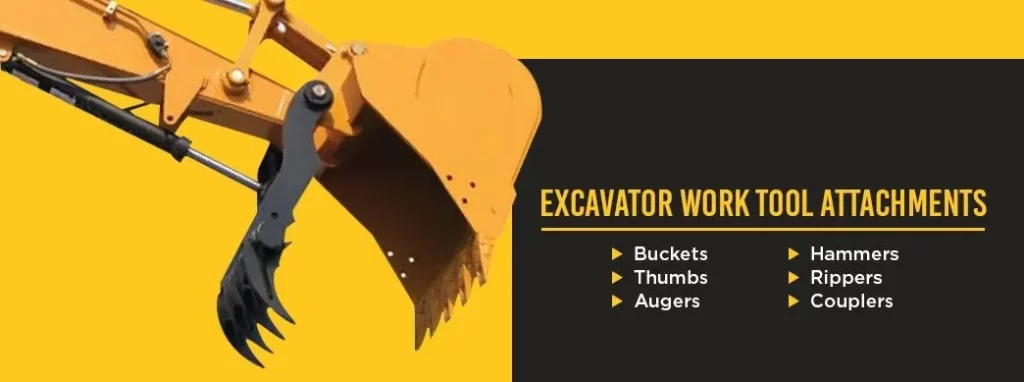
Standard excavators are versatile machines on their own, but work tools and attachments can extend these capabilities even further. If you are looking for an excavator that can do it all, look for one that supports a variety of work tools. Here are a few popular excavator work tool attachments to increase the productivity of your excavator.
Adding work tool attachments to your excavator enables you to tackle various tasks with a single machine.
Excavators come in various sizes to suit every project, from backyard landscaping to large-scale commercial construction. Understanding the benefits and challenges of different sizes of excavators can help you make an informed decision about the right size excavator for your job. There are three primary excavator size classes according to the machine’s weight which can you can find in the following excavator size chart.
Mini or compact excavators include any excavating equipment weighing less than 7 metric tons. These excavators are best suited for tight job sites where standard-sized excavators can’t fit or maneuver properly.
You can use mini excavators for small landscaping jobs that require creating trenches for infrastructure or digging holes for trees. Operators can use mini excavators around structures because they have zero or near-zero tail swings. Additionally, mini excavators are more precise than larger alternatives, making them suited to jobs where you need to install underground pipes or gas lines.
Mini excavators are easier to transport than standard or large excavators. These machines also require less fuel, which helps reduce operational costs. Further, because mini excavators are lighter, you can use them when operating on soft ground or finished job sites without risking damage. However, it’s essential to remember that mini excavators don’t have the same power as standard or large excavators and may not have the capacity for specific jobs.
Standard-sized excavators weigh between seven and 45 metric tons. These versatile excavators are the most common size for commercial construction projects and offer enough power and hauling capacity to handle tough jobs. Many hydraulic standard excavators can also support a variety of work tools, so contractors can customize their excavators to suit their project needs.
Standard excavators are still easy to maneuver and can significantly increase productivity on a job site. However, the larger size and weight of standard excavators can damage soft soil or finished sites. Some excavators can also be challenging to use in tight spaces, depending on their size, reach and tail swing. Standard excavators can be heavier than other types, creating storage and transportation challenges.
You may sometimes see standard excavators broken into two excavator weight classes — small and medium excavators. Small excavators are those at the bottom of this size class that weigh between 7 and 10 tons. The small size and low tail swing of midi excavators mean they are helpful for many of the same tasks as mini excavators, but offer more power, reach and dig depth.
Large excavators can weigh more than 45 metric tons. These weighty machines are best suited for heavy-duty work, such as commercial construction or demolitions. You can use large excavators to dig foundations for large structures like apartments or shopping malls. Large excavators can also be used to move large amounts of soil for civil engineering processes.
Transportation and storage can be challenging with larger excavators but may be worth the investment if you need to tackle a heavy-duty excavation project.
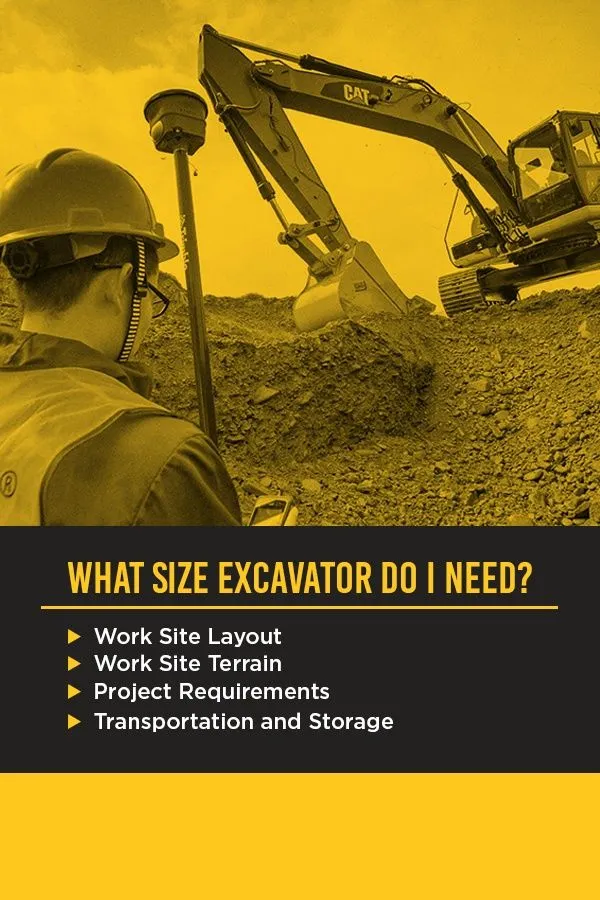
There are many options for excavator types and sizes, and choosing the right excavator depends on numerous factors. You’ll want to find an excavator that has enough power and strength to efficiently complete different tasks at your job site while lowering operating costs.
If you rent an excavator for a single project, evaluate the requirements and work site when choosing your excavator. If you are purchasing an excavator for long-term use, consider the types of projects your company typically takes on. Choose an excavator that will meet your standard job requirements and perform well on the sites where you most often work. To make the most of your investment, look for an excavator that can keep up with your company’s growth in the future.
Consider these factors when determining what size excavator you need.
First, consider the size and layout of your job site. Will you work in a small area with tight spaces and obstacles to navigate or enjoy a wide-open plot of land with no interferences?
If you work in a small space or on a site with many hazards, a compact mini excavator may be the right choice. A smaller excavator may also be a wise choice if your job site has a lot of underground obstacles, such as pipes and gas lines. Mini and small excavators will have smaller buckets and more precise controls to safely avoid underground hazards while excavating efficiently.
If your job site has more maneuverable space, you can use a standard or large excavator comfortably. However, remember to account for future hazards that may appear as your construction project progresses.
The tail swing of an excavator also impacts how easily it can navigate in tight spaces. Larger excavators typically have a larger tail swing, requiring more counterweight to remain balanced. This rear extension can pose problems when working near walls or buildings and harm workers if not operated safely.
Many mini and small excavators offer zero or near-zero tail swing, so they can rotate safely without damaging surrounding trees or structures. Excavators with zero tail swing are popular for urban or residential work sites. However, excavators with zero tail swing typically have a larger footprint and tracks that are wider apart to provide stability while turning.
Different types of excavators work better on various terrains. Tracked excavators offer excellent traction and stability on hilly and soft ground, while wheeled excavators work best on hard and flat surfaces. However, the weight of an excavator also impacts how well it performs on specific terrain.
Large and standard excavators can exert a lot of pressure and tear up a job site if the ground is weak. For some jobs, this may not be an issue if the earth gets leveled later in the construction project. However, working on a finished site, such as a backyard or other residential space, requires greater care to prevent damage to the terrain. Mini excavators are safe to use on finished sites without harming the ground.
When considering the weight of an excavator, account for the maximum operating weight rather than how much the machine weighs alone. The operating weight will include the weight of the excavator operator and the load the equipment will haul.
After accounting for your work site conditions, consider the typical tasks your excavator will need to perform. You should pick an excavator size that can handle your digging, lifting and hauling needs without struggle or sacrificing efficiency. If purchasing an excavator for long-term use, look at the requirements of past projects to get a sense of your future needs. Account for any potential growth, and choose an excavator that will suit your company’s needs for years to come.
Here are a few project requirements to consider when choosing the right excavator size.
An excavator that’s the right size will be able to meet all your project requirements while safely maneuvering around your job site. If an excavator cannot match your job needs, consider upgrading it with a new boom or bucket to extend its capabilities.
Another important consideration when choosing between the different sizes of excavators is each size’s transportation and storage requirements.
Transportation of large and standard excavators can be expensive, requiring special permits and equipment. If you plan to transport your excavators on your own, ensure you have the vehicles and trailers to do the job and drivers with the required licenses for moving heavy equipment. You may also work with an equipment transportation company to reduce the transportation costs of carrying your large excavators. Standard-sized trailers can move mini excavators, but depending on your state, you may still require special permits or licenses.
If you plan to purchase an excavator for long-term use, ensure you have the appropriate storage facilities for the size of the excavator you choose. You can also rent a storage space during the offseason to cut expenses. For infrequent use, renting an excavator instead of buying one may help you save money on storage and transportation costs.
As the leading heavy equipment manufacturer for construction and mining, Caterpillar® offers various excavator sizes and types for any application. Cat mini excavators are available in several different models and are perfect for landscaping, urban and residential construction and small building projects. Cat mini excavators offer power and durability in a compact machine that is easily controlled with precision. Choose between standard, zero and near-zero tail swing options to suit your work site and project needs.
Cat standard excavators supply the power to tackle tough jobs, from trenching to materials handling. Designed for speed and efficiency, Cat standard excavators can maximize your productivity and reduce your operating costs. Our durable excavators also require less maintenance and reduced fuel consumption.
Cat next-generation excavators take this exceptional performance to the next level, offering even better efficiency and productivity than ever before. Available in 20-ton and 30-ton models, Cat next-generation excavators can increase efficiency by as much as 45% while lowering fuel consumption by up to 25% and reducing maintenance expenses by up to 20%. Our next-generation excavators can help you meet your production goals, slash your operating costs and tackle any tough job that comes your way.
For the most challenging jobs, Caterpillar offers several heavy-duty large excavators for construction, mining, farming and more. These industrial workhorses offer serious digging and lifting capabilities to make short work of any excavation project. Despite their massive size, Cat large excavators still provide the excellent fuel efficiency and performance Caterpillar is known for.
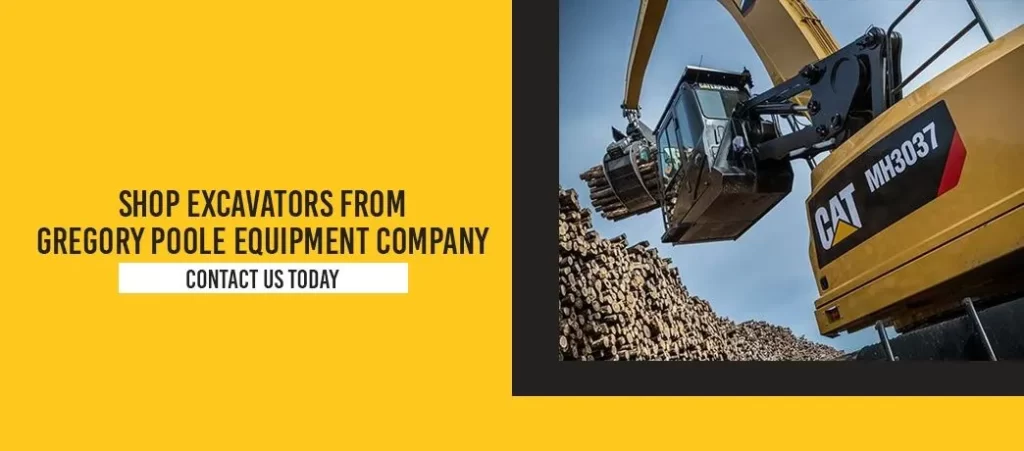
If you are looking for a reliable, efficient and powerful excavator, look no further than Gregory Poole. We offer various mini, standard and large Cat excavator models to meet and exceed your project requirements. With both new and used Cat excavators for sale, you can find an excavator that fits your needs and budget. Because Cat builds durable, built-to-last equipment, many of our used excavators offer the same excellent performance and durability you can expect from our new machines.
For even more flexibility, consider renting an excavator from Gregory Poole. When you rent a Cat excavator, you can enjoy improved performance and efficiency at a fraction of the cost. With short- and long-term rental options available, you can rent an excavator for a single project or an entire season. Contact us today for more information about new, used or rental excavators from Gregory Poole Equipment Company.